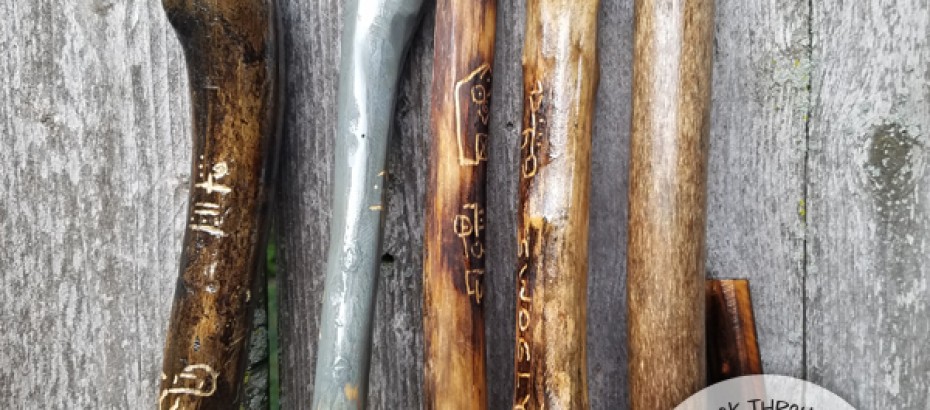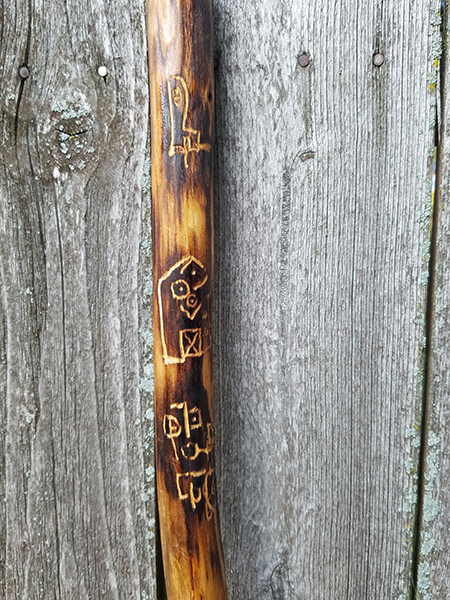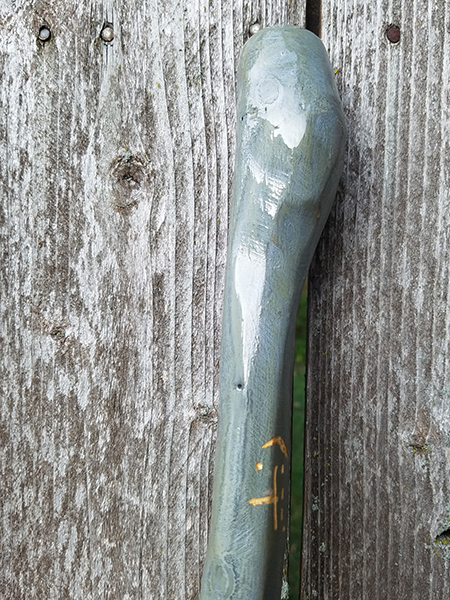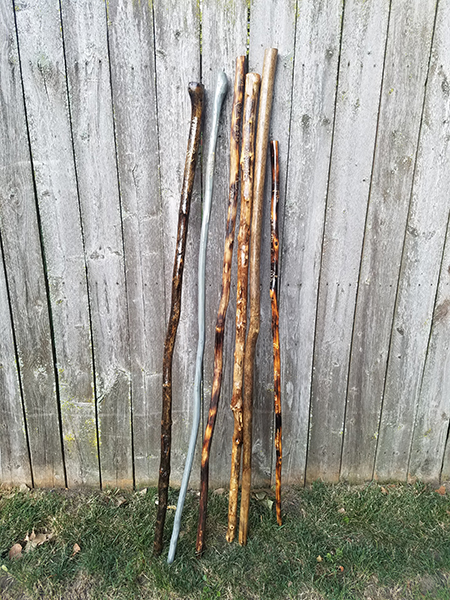“In a world of right and wrong, we have art,” says Ian Gefert, an Erie resident who sheds some new light on one of nature’s most underappreciated gifts, the stick. Ian has created a side business in which he adds an artistic, cultural, and sometimes magical flair to an ordinary stick, immortalizing and giving life to a practical tool we like to call the hiking stick.
Ian went to Cathedral Preparatory High School. The Catholicism stirred in him an interest in religion and spirituality, and a desire to study different cultures, like ancient Greece. In addition, his reading of The Odyssey sparked in him an interest in ancient and old things. He graduated in 2012 and went on to study Anthropology at Edinboro University. There, he became interested in high fantasy, and his love for the archaic, ancient history, and magic grew. He noticed that many high fantasy characters had wizard staffs to accompany them, and the wheels began to turn. Eventually, he started his side business Betwixt: Fine Wands & Staffs. The word Betwixt is derived from the Old English word for “in between.”
“Art is a philosophy symbolized by an object,” says Ian. He implements Japanese philosophy into his work, appreciating the simplicity of the object. In other words, he doesn’t like to alter the sticks too much because he feels that the nature itself is art and doesn’t want to ruin its integrity.
I sat down with Ian to discuss his interest in ancient culture and the art form that was birthed from that interest.
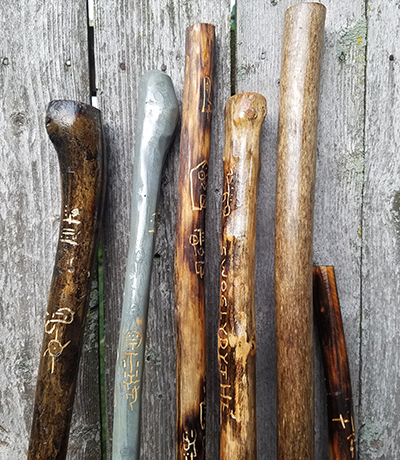
Where did the idea for the hiking sticks come from?
I once went to a local store and bought a walking stick made of pine adorned with a bear head, but it broke very easily, too easily for the price I paid. So, I thought to myself; I could find sticks in the woods that would be more durable and less expensive to sell. A lot of my influences come from my love of history and anthropology, different cultures. My biggest inspiration is nature. I want my artwork to be one with nature.
What do you look for that makes a good basis for a hiking stick?
Strength. At least enough to where you can put your body weight on it and it can support you. I also look for durability. Can someone take this stick on an extreme hike? I also want it to be straight. Finding a stick straight enough for me is very difficult. I do like curves, they make it more interesting, but the top and bottom have to be parallel. Quality is a huge factor. I like to know the tree it came from, but that’s not always possible. The stick cannot have any significant weak spots. Any cracks in the stick must be vertical. Horizontal cracks compromise the stick’s integrity far too much, causing it to break easily.
Describe one of your favorite hiking sticks.
I wish I had a picture of it, but I gave it away. It’s the perfect staff, solid, unbreakable. You can use it for anything from self defense, to hiking, music festivals, bon fires, even comic conventions. It had three to five coats of polyurethane, so it was incredibly shiny. I didn’t carve it because it was perfect as it was; I hardly had to alter it at all. What makes a stick perfect is nature giving me something cool more than it is me making something really cool out of it.
What cultures are you most inspired by?
Scandinavian, Hellenic (Greek), Norse, and Baltic. I’m interested in European cultures in general. The folk songs from ancient Europe really inspire me. I went through a Celtic phase, when I watched the show Merlin. I even adopted a kitten and named it Merlin.
How has your interest in anthropology influenced your art?
It influenced the mindset. I have always studied it and appreciate movies that focus on ancient times, like 10,000 B.C. I feel at home studying ancient things. I can look at a stick and think it gives off the vibe of being prehistoric, Roman, etc. From there, I will look into that culture more, researching for inspiration. It’s more about inspiration than knowledge.
Do you go in with an idea or do you just start creating and see where it takes you?
I used to always have an idea going in, but lately I’ve been going about it in the moment. My process now comes from the standard writer’s block for artists. I want to go in and just do something despite the creative block. I use my dremel and carve what I like to call “inspired runes.” They just come to me in the moment. I refer to them as alien runes, because they look otherworldly.
My sticks are more spiritualist now than fantasy. My process is constantly evolving, and a lot of it is experimentation. I can go months without working on a stick and then create one with excitement. To me, the most important thing as an artist is to let go of the control of the art. I strive to find that balance between having fun and remaining critical in a healthy way. I want to make something unique, but not alter to the point that it ruins the integrity of the stick’s natural origins.
What are some of your favorite techniques to implement?
I like sanding the sticks and stripping them of their bark, leaving a smooth surface. I have shaved the bark off in the past in order to achieve a rugged appearance. I shave off the roughness using my electric sander until the stick is relatively smooth. From there I sand by hand, exposing a light wood color that almost appears as a mixture of white and yellow. Sometimes I use a blowtorch to char parts of the stick. This process is a lot less messy than painting and yields a much more natural looking result. I do not carve into them very often, because I often hear the sticks say to me, “just let me be a stick.” The way I see it, I don’t make the stick. I find the stick and alter it. My favorite part is putting the polyurethane on. It solidifies the work, immortalizing it.
Do you ever mix cultural references within one stick?
I usually do not, but I decided to experiment with this idea when I bought a stick with deer antlers at a garage sale. I thought about how deer live in many places, and I wanted to make a stick representing three cultures. I carved into it the lightning bolt of Zeus, a Celtic swirl, and a Nordic symbol called Valknut, which is the symbol of fallen soldiers. This particular stick, however, was challenging for me because I do tend to focus on one culture per stick.
Who is your target buyer?
Everyone. Mainly artists and spiritualists, people who appreciate them beyond a hiking sticks. Someone who appreciates them for what I intend. There is more to them than their stick form, and I hope to get more people to think that way. Most people don’t think of walking sticks as art, and I want to change that mindset. I want to immortalize it. A walking stick I make could last five hundred years. As humans, I think we want to connect with something immortal because we are mortal. Art is immortal because it’s shared, and human beings want to share.
If you could take your art in any direction without fear of failure or rejection, where would it lead?
I would branch out more than I am right now, maybe making jewelry, working with metal, etc. I would also expand my knowledge and skill set into other types of woodwork. People might think I’m going in too many directions if I learn too many different things. I’ve decided, at least for now, to stay in a niche. It would be cool, though, to make swords, sculptures, and extraordinarily skilled things. I would make mythological, otherworldly things, out of the box weapons.
Thank you, Ian, for taking the time to talk with me. You can keep up to date with his latest projects on Facebook. Who knows? You just might find a stick you want to take with you on your next adventure.

